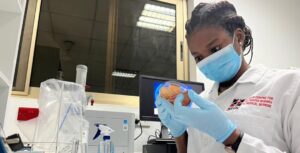
Cattle roaming freely on Bangladesh streets increase health and environmental hazards
A research article recently published in Bangladesh Journal of Animal Sciences discusses the public health and environmental hazards of livestock rearing in urban areas. The article is made available online via Bangladesh Journals Online (BanglaJOL), supported by INASP.
Dr MAK Azad and his team at the Department of Animal Science, Bangladesh Agricultural University carried out a research project to assess the impact of livestock rearing on public health and environment in some municipalities of Bangladesh.
The research, carried out among 90 farmers in the Mymensingh, Gazipur and Shariatpur municipalities, showed that disease outbreaks related to ecto-parasites, mastitis, helminthosis, lumpy skin disease, wounds, and diarrhoea were common to the study area.
Although, a categorical link between the disease outbreaks and livestock rearing hasn’t been established in the research article, lead researcher Professor Dr MAK Azad claims livestock play a significant role in increasing the risk of diseases.
“Most of the disease outbreaks are Zoonotic diseases and Zoonotic diseases are communicated to humans from livestock,” says Dr Azad.
Dung and urine disposal in public places, malodour and road blockages are other problems created by livestock rearing in urban areas. The problem is aggravated by unmanaged fodder and shelter for the livestock.
The research findings have shown that 86% of the livestock were kept in temporal sheds. They also showed that two thirds of the total livestock reared in the urban areas roamed freely on the roadside and fed on garbage, and 79% drank water from drainage lines. The pathogens, heavy metals and other chemicals consumed by the animals pass to humans in the food chain through dairy and meat products.
Most (68%) of the livestock reared in the study area are reared for dairy purposes, while 24% were reared for beef.
Despite the grave risk to public health and environment, little effort has been made to curb the situation. The law is silent on the issue and there is no database or estimation of how many cattle are reared in the urban areas.
“There is no regulation related to banning livestock in urban areas,” says Dr Azad. “Moreover, it’s mostly the politicians and the “musclemen” that keep the livestock. So nobody can raise a finger against them.”
Indeed, the research findings show that 58% of the livestock keepers were politicians and 26% were self-employed traders, both powerful sections of the society. That could be the reason why no precautions or care is taken in rearing livestock in a managed way in order to reduce the adverse impact, although most livestock owners had basic education and all of them were aware of the negative impacts of livestock rearing in urban areas. The research showed that 100% of the participants were aware of the adverse effects that livestock rearing would have on public health and environment and 73% had at least primary education.
“Serious steps need to be taken to bring this situation under control as it could invite uncontrollable epidemics if it goes unchecked,” says Dr Azad.
The rise in the urban population in Bangladesh has increased pressure on the already-strained city infrastructure and job market. Poverty is moving to the cities from the villages. Many urban dwellers are using livestock rearing for beef and dairy as an additional income source to meet their growing needs at the cost of public health and environmental hazards.
In his next research on a related topic, Dr Azad says he has found the presence of heavy metals like mercury, lead, chromium and manganese in animal products.
The article “Impact of livestock rearing practices on public health and environmental issues in selected municipality areas of Bangladesh” appears on a recent issue (Vol. 45(1), 2016) of Bangladesh Journal of Animal Science, pages 44-51. Dr Azad was funded by Bangladesh Agricultural University Research System for the study.
About the Journal
Bangladesh Journal of Animal Science (BJAS) is an official publication of the Bangladesh Animal Husbandry Association (BAHA) and is published three times a year. It aims to publish original full-length papers, review articles and short communications from all areas of livestock and poultry production such as basic and applied matters of genetics, breeding, nutrition, biochemistry, management, statistics, economics, disease control and related technologies. It accepts articles from authors around the world.
About BanglaJOL
BanglaJOL is a database of journals published in Bangladesh. It was initiated in June 2007 and officially launched in September 2007 with the support of INASP. The objective of BanglaJOL is to give greater visibility to the participating journals, and to the research they convey. It is managed locally by the Bangladesh Academy of Science (BAS). It provides open access to the full text of research articles published in 139 different journals from a wide range of academic disciplines and genres.
About INASP
INASP is an international development charity working with a global network of partners to improve production, sharing and use of research information and knowledge, so that countries are equipped to solve their development challenges. In particular, INASP works to strengthen the availability, access and use of international research information by researchers in developing countries and the production, quality, dissemination and access of research outputs from researchers in those same countries.
Disclaimer: Research published in journals hosted on the BanglaJOL platform is selected by the journals in accordance with their own editorial processes and criteria. INASP and BanglaJOL provide hosting and guidance on good practices but are not involved in selection of research.
For Further Information
Thakur Amgai, Communications Consultant, INASP
email tamgai@inasp.info
Dr Sangita Shrestha, Communications Officer, INASP
email sshrestha@inasp.info

 Previous Post
Previous Post Next Post
Next Post


